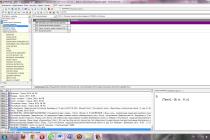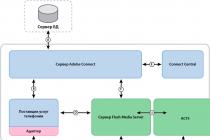In this article, we will look at connecting a Netgear N300 router to personal computer, connection to wireless network as well as popular Internet service providers.
Let's consider such important details as setting up IPTV, updating the device's firmware and restoring its configuration.
Connection
So how connect the Netgear N300 router to the computer?
Photo: appearance Netgear N300 router

Now let's move on to setting up network card to set the automatic acquisition of the IP address.
For Windows 7, follow these steps:


If you are using Windows XP, the process will look slightly different:
- go to the start menu, then "Control Panel" and "Network connections";
- choose "Connection by local network» and "Properties";
- in the "General" tab we find "Internet Protocol";
- we activate automatic obtaining of IP and DNS-addresses, click "OK".
After this procedure, an internal IP address will be assigned for the current computer.
Login to the interface
To enter the router interface in any browser, enter the following URL: http://192.168.1.1... An authorization window will appear, in which you must specify the login and password (login - "admin", and password - "password"), which will open access to the user interface.

Photo: Netgear N300 router interface
How to set up WIFI router Netgear N300
Dynamic IP Connections
Some providers use a dynamic IP connection, that is, an address that is assigned to a device during connection and is used only until the session ends.
To set up such a connection, you must:

PPPoE for Rostelecom, TTK and Dom.ru
Rostelecom, TTK and Dom.ru use the PPPoE connection type.
Follow following instruction to configure them:

Dom.ru uses a binding to a MAC address, so it requires a few additional manipulations, similar to those described in the previous paragraph. In the "MAC Address" section, we agree to the use of your PC's address.
L2TP for Beeline
For Beeline, the connection will be different from those described above, because this operator uses the L2TP connection type.
In this case, we do the following:

Wireless network
Let's go to the settings wireless connection:
- in the router interface, go to the section "Wi-Fi network";
- in line Name (SSID) we give the name of the new network;
Note! When naming a wireless network, it is better to start its name with a capital letter, as some devices (for example, tablets or phones) do not always correctly perceive names with a capital letter.

The connection is created and ready to go.
IPTV
Before the start IPTV settings for Netgir N300, one point should be taken into account: in the case when the Vlan ID is required to use IPTV, it will not work, since it can only allocate a separate port and direct an incoming stream to it.
If this is not required, then we just need to specify the port to which the STB set-top box is connected:

Firmware upgrade
Despite the seeming complexity of the process, you can completely flash the router yourself. This will require two files - the firmware needed for direct update and configuration - for the subsequent configuration of the device.

If you cannot go to the web page with the settings (a prerequisite for point 4), then you must first return the device to its factory configuration.
This can be done as follows:
- we find on the back of the router the reset button located in a small recess;
- we clamp it with a pen or paper clip for about 10 seconds;
- after the indicator starts flashing - release the button and wait for the reboot;
- we enter the device menu using the default password.
Video: Netgear wireless N300
There are times when this is not enough to reset the settings, then additional steps will be required:
- turn off the power of the router and hold down the reset button;
- holding it, turn on the device;
- wait for about 20 seconds after turning on, when the router flashes again and reboots;
- use the default password to login.
After completing the firmware update, you need to configure the router using the configuration file:
- we connect the computer and the LAN port of the device;
- go to section "Manage settings" and then "Restore settings";
- here we download the file via the router's web interface (the "Select file" option) and save it on the computer;
- push "Send" and wait for the automatic reboot;
- after starting, re-enter the username and password ("admin" and "password").
Attention! When restoring the default settings of the router, it stops asking for a username and password when connecting external devices to it. This can result in people being able to connect to your network. wireless devices, for example, neighbors. You can fix this by setting a new username and password in the router menu.
We hope that this information helped you to cope with setting up the device and answered all your questions. Be sure to bookmark this page for future reference.
In this article, we will consider connecting the Netgear N300 router to a personal computer, connecting to a wireless network, as well as to popular Internet providers.
Let's consider such important details as setting up IPTV, updating the device's firmware and restoring its configuration.
Connection
So how connect the Netgear N300 router to the computer?

Now let's move on to configuring the network card to set up the automatic acquisition of the IP address.
For Windows 7, follow these steps:


If you are using Windows XP, the process will look slightly different:
- go to the start menu, then "Control Panel" and "Network connections";
- choose "LAN connection" and "Properties";
- in the "General" tab we find "Internet Protocol";
- we activate automatic obtaining of IP and DNS-addresses, click "OK".
After this procedure, an internal IP address will be assigned for the current computer.
Login to the interface
To enter the router interface in any browser, enter the following URL: http://192.168.1.1... An authorization window will appear, in which you must specify the login and password (login - "admin", and password - "password"), which will open access to the user interface.

How to set up WIFI router Netgear N300
Dynamic IP Connections
Some providers use a dynamic IP connection, that is, an address that is assigned to a device during connection and is used only until the session ends.
To set up such a connection, you must:

PPPoE for Rostelecom, TTK and Dom.ru
Rostelecom, TTK and Dom.ru use the PPPoE connection type.
Follow the instructions below to configure them:

Dom.ru uses a binding to a MAC address, so it requires a few additional manipulations, similar to those described in the previous paragraph. In the "MAC Address" section, we agree to the use of your PC's address.
L2TP for Beeline
For Beeline, the connection will be different from those described above, because this operator uses the L2TP connection type.
In this case, we do the following:

Wireless network
Let's move on to the wireless settings:
- in the router interface, go to the section "Wi-Fi network";
- in line Name (SSID) we give the name of the new network;
Note! When naming a wireless network, it is better to start its name with a capital letter, as some devices (for example, tablets or phones) do not always correctly perceive names with a capital letter.

The connection is created and ready to go.
IPTV
Before you start configuring IPTV for Netgir N300, you should take into account one point: in the case when the Vlan ID is required to use IPTV, it will not work, since it can only allocate a separate port and send an incoming stream to it.
If this is not required, then we just need to specify the port to which the STB set-top box is connected:
- go to the router settings and select "Advanced mode";
- go to "Settings" and then "Internet Port Settings";

- check that opposite the option Disable IGMP Proxy there was no check mark (usually inactive by default);
- find "Redirect IPTV stream for a set-top box "and indicate the port to which the STB-set-top box is connected or is planned to be connected;
- save the changes with the "Apply" button.
Firmware upgrade
Despite the seeming complexity of the process, you can completely flash the router yourself. This will require two files - the firmware needed for direct update and configuration - for the subsequent configuration of the device.

If you cannot go to the web page with the settings (a prerequisite for point 4), then you must first return the device to its factory configuration.
This can be done as follows:
- we find on the back of the router the reset button located in a small recess;
- we clamp it with a pen or paper clip for about 10 seconds;
- after the indicator starts flashing - release the button and wait for the reboot;
- we enter the device menu using the default password.
Video: Netgear wireless N300
There are times when this is not enough to reset the settings, then additional steps will be required:
- turn off the power of the router and hold down the reset button;
- holding it, turn on the device;
- wait for about 20 seconds after turning on, when the router flashes again and reboots;
- use the default password to login.
After completing the firmware update, you need to configure the router using the configuration file:
- we connect the computer and the LAN port of the device;
- go to section "Manage settings" and then "Restore settings";
- here we download the file via the router's web interface (the "Select file" option) and save it on the computer;
- push "Send" and wait for the automatic reboot;
- after starting, re-enter the username and password ("admin" and "password").
Attention! When restoring the default settings of the router, it stops asking for a username and password when connecting external devices to it. This can result in wireless devices such as neighbors being able to connect to your network. You can fix this by setting a new username and password in the router menu.
We hope that this information helped you to cope with setting up the device and answered all your questions. Be sure to bookmark this page for future reference.
Good afternoon.
In today's next article dedicated to setting up a home Wi-Fi router but, I would like to focus on TP-Link (300M Wireless N Router TL-WR841N / TL-WR841ND).
Quite a lot of questions are asked about TP-Link routers, although in general, the setup is not much different from many other routers of this type. And so, let's take a look at the steps that need to be done to make both the Internet and the local Wi-Fi network work for you.
1. Connecting a router: features
There are several outputs on the back wall of the router, we are most interested in LAN1-LAN4 (they are yellow in the picture below) and INTRNET / WAN (blue).
So, using a cable (see the picture below, white), we connect one of the LAN outputs of the router to the computer's network card. Connect the cable of the Internet provider that enters your apartment from the entrance to the WAN output.
That's all. By the way, after turning on the device, you should notice the blinking of the LEDs + a local network should appear on the computer, while without access to the Internet (we haven't configured it yet).
Now you need go to settings router. To do this, in any browser, type in the address bar: 192.168.1.1.
Then enter your password and login: admin. In general, in order not to repeat myself, here is a detailed article about that, by the way, and all the typical questions are sorted out.
2. Configuring the router
In our example, we use the PPPoE connection type. Which type you choose depends on your provider, all information on logins and passwords, connection types, IP, DNS, etc. should be in the contract. We now carry this information into the settings.
2.1. Configuring the Internet (PPPoE type)
In the left column, select the Network section, WAN tab. Three points are key here:
1) WAN Connection Type - indicate the type of connection. It will determine what data you need to enter to connect to the network. In our case, PPPoE / Russia PPPoE.
2) Username, Password - enter your login and password to access the Internet via PPPoE.
3) Set the Connect Automatically mode - this will automatically allow your router to connect to the Internet. There are modes and manual connection (inconvenient).
Actually everything, the Internet is configured, press the Save button.
2.2. Configuring a wireless Wi-Fi network
For settings wireless wifi network, go to the Wireless settings, then open the Wireless Settings tab.
Here you also need to pay attention to three key parameters:
1) SSID is the name of your wireless network. You can enter any name, the one that will be convenient for you to search later. The default is "tp-link", you can leave it that way.
2) Region - choose Russia (well, or your own, if someone reads a blog not from Russia). This setting is not found in all routers, by the way.
3) Check the boxes at the very bottom of the window, opposite Enable Wireless Router Radio, Enable SSID Broadcast (thereby enabling the Wi-Fi network).
Save the settings, the Wi-Fi network should start working. By the way, I recommend protecting it with a password. More on this below.
2.3. Enabling a password for a Wi-Fi network
To protect the network Wi-Fi password, go to the Wireless section, the Wireless Security tab.
At the very bottom of the page there is a choice of WPA-PSK / WPA2-PSK mode - select it. And then enter the PSK Password that will be used every time you connect to your wireless network.
Then save the settings and reboot the router (you can just turn off the power for 10-20 seconds).
Important! Some ISPs register the MAC addresses of your network card. Thus, if your MAC address changes, the Internet may become unavailable to you. When you change a network card or when installing a router, this address changes for you. There are two ways:
first- this (I will not repeat myself here, everything is detailed in the article; TP-Link routers have a special section for cloning: Network-> Mac Clone);
second- register your new MAC address with the provider (most likely it will be enough phone call in those. support).
That's all. Good luck!
Under the N 150 brand, D-Link offers universal routers of the DIR-300 and DIR-300NRU models, one of their latest revisions. The solution in the form of a "100-megabit" router, equipped with one additional "150-megabit" Wi-Fi antenna - is well suited for building both home and office networks... Therefore, the D Link n150 router will be in demand, and the company will continue to update hardware revisions and firmware. Let's consider the option of configuring the main functions of the device in a graphical interface with a "white-blue" design, the manual for which on the official website is now missing.
Router D-Link N150
What does the combination "N 150" mean? Wireless networks are known to operate according to one of three protocols: 802.11 B, either G, or N. The "802.11 G" protocol can provide a maximum connection speed of up to 54 Mbps, while "802.11 N" - up to 150 (this is when using one radio channel). Actually, the last of the options is implemented in N 150 routers.
It is desirable that all subscriber devices in Wi-Fi networks- could also work with the "N" protocol. But if this condition is not met, it will be enough to switch the router to the "mixed" mode, and any device will be able to work in the wireless network (even using the now outdated 802.11 G protocol). Let's start setting up.
Configuring Basic Router Functions
Installation and Connection Preliminary Steps

Router DIR-300 with Wi-Fi 150Mbps
On the rear panel of the device there are four LAN ports (for connecting local computers, NAS drives, etc.), as well as one “Internet” port. The provider's cable is connected to the last port (the port is also called "WAN").
Configuration is performed in the web interface. Before configuring the router, you must complete the following hardware connections:
- In the "Internet" port - install the network cable connector of the provider
- Any of the LAN ports - connect to the wired network card of the PC (using the supplied patch cord):

Connecting the router to a computer for subsequent configuration
- Power supply of the router now - do not turn it on. It is necessary to check the correctness of the wired connection settings:

Configuring a network card on a computer
- At the last stage, connect the power supply, turn on the router. In about a minute, you will be able to enter the graphical web interface (when the device is booted up).
To enter the web interface, open a browser on your computer and navigate to the address: 192.168.0.1. The following image should appear on the screen:


Main GUI tab
Here, of course, you need to click on the "Configure manually" button. Next, we will consider how to configure the Internet connection.
Connection setup (DHCP option)
If the provider "distributes" the Internet via DHCP, it will be easy to set up a connection in the router. In the web interface, go to the "Network" -> "Connections" tab:

Router connections tab
Where you need to click once with the left button on the line with the inscription WAN. A page will open where you can set the connection parameters:

Setting up a connection "under DHCP"
Additional configuration for DHCP connections is not required. If you plan to view IPTV, check the Enable IGMP checkbox. If it is necessary to change the MAC address, the new value must be set in the corresponding field (MAC). In the list "Connection type", in addition to "IPoE" (for us it is "DHCP connection"), there are three more options that should be considered separately. These are L2TP, PPTP and PPPoE.
After completing the necessary settings, click "Save" in the lower right corner of the page. The interface will return to the Connections tab. Check that the "Default Gateway" point remains on the connection that we configured (if there are several). Then you need to click "Save" in the right upper corner tabs.
A few seconds after saving the parameters, the Internet connection will appear automatically. You can verify its presence on the "Status" -> "Network Statistics" tab:

Device status tab
Additionally, let's say about configuring other types of connections (for example, PPTP). In this case, the IPoE connection should remain (you need to click the "Add" button and set the PPTP parameters). At the same time, even if the IGMP service is used, the IGMP checkbox is set only (!) In the IPoE settings, if necessary.

Connections tab after PPTP setup
Successful setup!
Enabling Wi-Fi
Setting up a wireless network in your router is easier than any type of connection. On the "Wi-Fi" tab -> " General settings"The checkbox" Enable wireless connection "must be checked. To configure the network parameters (name, etc.), you need to go to the next tab - "Basic settings":

Wi-Fi setup
You need to follow the steps:
- In the "SSID" field - set the value of the network name
- "Country" - leave "default"
- "Channel" - the number of the radio channel (from 1 to 13). It is recommended to use "auto" (then D Link n150 home router will enable the least noisy one)
- "Wireless mode" - the protocol of the wireless network, "N 150" or another. Better to leave "B / G / N mixed". Only if all subscribers support work with "802.11 N", to achieve the highest speed - you can select "N Only".
- "Maximum number of subscribers" - here zero means "auto".
The last remaining setting is the "Hide ..." checkbox. If you want to work on a hidden name, then install it. Finally, you need to click "Change" and wait for the tab to update. Then, in the upper right corner - click "Save".
Wi-Fi network protection can be set on the Security Settings tab:

Configuring Wireless Encryption
Wireless network with new parameters - will appear after restarting the router. In the top menu, you must select the following:

System menu at the top of the tab
It is saving with reboot that will allow you to immediately turn on the Wi-Fi network. Remember that the router will take about 1 minute to boot up. Happy routing!
Additional router features
IPTV setup
You can watch IPTV through a set-top box or through a computer connected to the router's network. The setting option in either case is different. Here is how the D Link n150 router is configured for broadcasting IPTV to a local network (viewing on a computer).
First of all, in the settings for connecting to the Internet - you must check the "Enable IGMP" box. Moreover, it should be set only for "IPoE" connections. What was discussed above.
However, this is not all it takes to watch IPTV. There is a tab in the web interface called "IGMP":

IGMP Tab
It's in the list of Advanced tabs. And it contains one checkbox ("Enabled", it must be installed), and a list of version numbers ("2" is recommended). Configure the settings on the IGMP tab, click Edit, then Save.
After completing these steps, you can watch TV channels through your computer. All multicast packets (used in IPTV) go to the local network.
Question answer
Question: how does Beeline's D150L router differ from D-Link N150?
Hardware - nothing (this is one model). Programmatically, the firmware is configured "for the operator" so that the user has to set a login and password:

The configuration interface of the Beeline D150L router
Conclusion: one router is no better (no worse) than another. At the same time, the Beeline device does not need to be configured for the network this operator... By the way, the interface address here ends with "1.1".
Question: how to reset the router settings if the interface cannot be opened?
Turn on the device. Wait 2 minutes. Press "reset" on the rear panel for 10 seconds. All indicators - 1 time "blink". In a minute, you can go to the web interface.
And here we have configured a router for PPTP:














